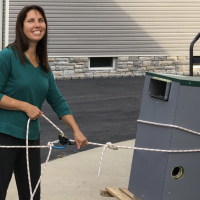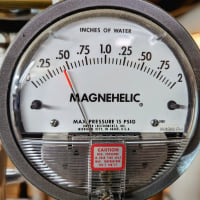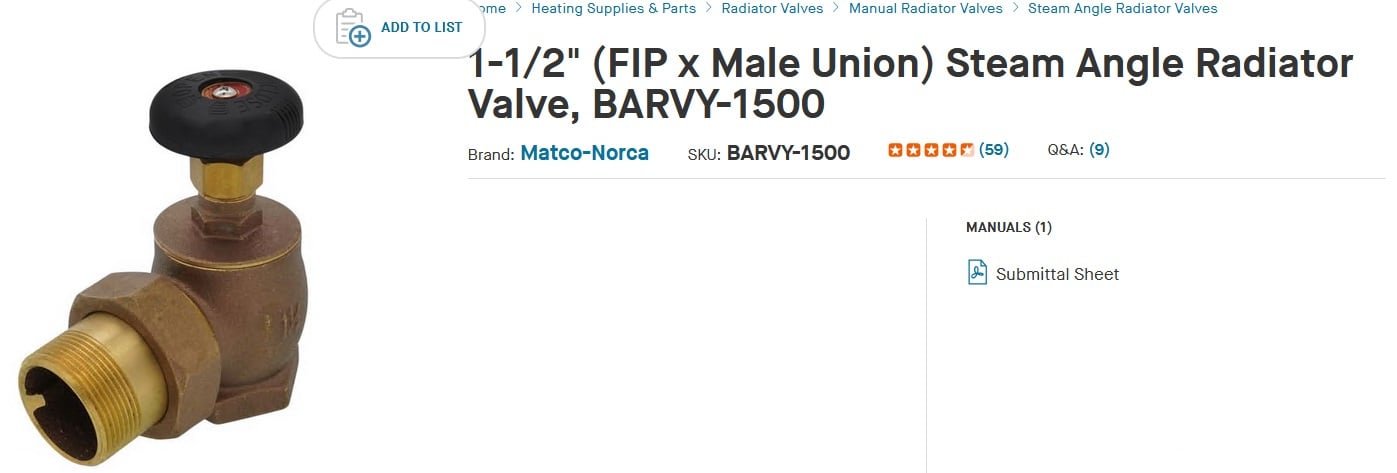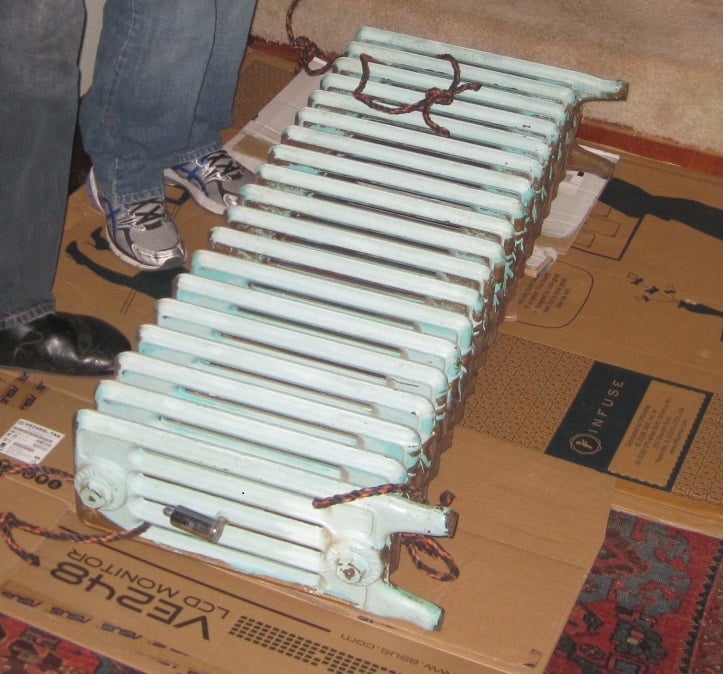DIY Boiler Installation -- Peerless 63-03
Comments
-
It's time for another update. I've enjoyed the process even if it seems overlong, and I hope this thread with all the bumps and delays is useful for someone else down the line.
#1 Skimming
After another 10 or so days had passed, the boiler was surging again, with ~2.5 gallons of water going skyward. Friday night I tested a hypothesis of mine — more like a suspicion — and found it confirmed: most of the effect of skimming occurs early. I filled half a Homer bucket with overflow, dumped another half bucket out the drain and out the [recently installed] drain valve of the wet return, and ran the boiler again.
Sure enough, the water level in the glass bounced up and down less than before — maybe 1/2" total movement — and the average drop in the water line was a little over a gallon late in the cycle. I don't think it's ever been less.
What this says about skimming is that there's no point in dragging it out for hours, and that adding detergent won't help. It's the oil slowly leeching out of the piping that's making the boiler surge, and that'll stop when it's all washed out. Probably three Christmases from now is what it feels like. It's an easy process, and it's slowly getting better.
Most importantly, we had a nasty cold spell and stayed comfortable throughout.
0 -
#2 Fuel Consumption
This was more of a lark than anything. I snapped a picture on two mornings before going to work.
By my math, we used 870 scf = standard cubic feet, and given there's roughly 1,000 BTU in a standard cubic foot, and lowballing ab bit to account for the stove and the water heater, we can calculate how many hours the boiler actually ran. Input to the boiler is 118 MBTU meaning 118,000 BTU per hour, so it ran for 7 hours, meaning not quite 1/4 of the time. Which is about what I've been seeing; on for 40 minutes and off for not quite two hours.This math stuff really works, who'd'a thunk it.
This was a day that started at 10 F, crested 17, and went back down to 12 overnight. A bit of wind, too. I ride my bike to work, only 5 miles round trip, but believe me, I'm tuned in to the weather.
0 -
#3 Insulation
I was inspired by an old thread (*) to buy thicker insulation for my near-boiler piping and carve it out, rather than use the standard one-inch thick material for the pipes and then work around the fittings. In the end, it'll probably be a combination of the two. It gets futzy around tight bends.
I'm encouraged by progress so far. Here are a few of pictures illustrating the process. A carpet knife is a useful tool for this. I'll probably finish with cheesecloth and mastic, and may use some standard 4" thick wall insulation to pad out the problem areas. It'll be interesting to see if there is a noticeable shortening of the startup time.
I'm doing all the carving-up outside of course. It was so cold that I waited until the afternoon when it warmed up to 31 degrees. It's been miserable. BTW the box that came from buyinsulationproductstore dot com was huge and put the shipping cost in perspective. This stuff ain't cheap but it appears well made and is worth it. Where it just snaps around the pipes it's a great fit, too.
(*) https://forum.heatinghelp.com/discussion/151757/insulation-pics-using-mitered-joint-technique
0 -
washing powder certainly helps when used as directed—immediately after the install. It will greatly reduce the oil in the boiler.
But surging throws all the oil in the boiler up into the pipes where as you say the oil is protected from the washing, and will then make its way back to the boiler later.
NJ Steam Homeowner.
Free NJ and remote steam advice: https://heatinghelp.com/find-a-contractor/detail/new-jersey-steam-help/
See my sight glass boiler videos: https://bit.ly/3sZW1el1 -
One thing I find fault with on domestic boilers that unnecessarily causes difficulty piping is the insistence of "pitching the header" This is a crock of BS. and requires crooked piping or more swing joints than necessary. Yes swing joints are required. Pitching the header is not required
And I am not zeroing in on this post, this is about all posts in general.
The amount of water the header can hold when level is insignificant. A few drips down the risers back into the boiler does nothing. Think about what is going on.
I have never in my 46 years in the field seen a commercial boiler with a 6,8,10" header with the header pitched.
Skim the boiler use the right size header and risers (or oversize the risers which I am a fan of) keep the water INSIDE the boiler where it belongs. It does NOT belong in the header where the water can kill some steam
How many old boilers are in operation with no header, just two separate supply pipes coming out one to the front of the building and one to the rear of the building, no equalizer. The boiler had a large steam chest to make dry steam.
The newer boiler will as well if a decent design and proper maintenance and follow the MFG instructions which may or may not call for an unnecessary header pitch
Just my Sunday rant.
2 -
Learned Friends:
Time for another update. Or more to the point, here is where I document my boiler project so I keep track of things for selfish purposes. Anyone is welcome to read along, of course, and I am grateful for any insights.
I skimmed, again. For the 12th time. The pattern is clear: after skimming off half a 5-gallon bucket of water, and draining as much from the bottom to get the water line back to normal, there is no surging for a few days. After a week, instead of dropping a gallon-and-a-quart, which is about the minimum water "loss", the water level goes down by over two gallons, indicating some more oil has found its way to the boiler. And I skim again. At the present rate, I'll be rid of the oil around Memorial Day, and I can only hope it'll be the 2025 one.
The other progress I've made is I'm over 90 % on the insulation, and its functional if not particularly pretty. I may leave it alone where it sits; see the pictures.
And I finally plumbed in the low-pressure gauge -- 0 to 30 inches of water -- with a shutoff valve, as per a suggestion on another thread, to avoid exercising the diaphragm too much, and eventually breaking it. I believe that was sound advice.
The observed pressure went as high as 15 inches of water, or 9 ounces per square inch, or four percent of atmospheric pressure, talking round numbers. That is higher than others have reported, but I don't think cause for concern. So far, the only time my boiler has ever cycled on pressure was when I forced the cut-in setting of the Pressuretrol off the scale with a screwdriver, while plugging most of my radiator vents. With the system set at 0.5 PSI cut-in, with a 1 lb differential, nothing.
What is hard to understand is that the pressure fluctuates in a weird pattern. Starts at zero, goes to 5 inches, and once the main vents close, ambles up to around ten. Later in the cycle it would hit 15 inches, only to go down to about 5 inches again for several minutes, and then to return towards 15 just as the call for heat ended. Just before this last 10-minute cycle, I'd been upstairs confirming that three or four radiators were hot all the way across, whereas most of them were still venting air. Go figure.
I'm not sure what to make of this behavior, and don't plan to worry about it, but I thought I'd write it up, now the data are available.
cheers -m
1 -
A friend of mine with a massive boiler was having this trouble getting the oil out. His pattern was:
- skim
- have good performance for a week or so
- boiler would surge
- go to 1
So I suggested he try:
- skim
- let the boiler do its thing for like 5 days, then go to 1 before it has a chance to surge
When a skim shows no sheen, you should be done
If you let it surge, then it will vomit the oil back up into all the pipes where the oil will hide from your skim.
The pressure will fluctuate as different parts of the system get steam to them. Before the main vents close you should have low pressure for sure. Then when the main vents close, you might see pressure rise a little. Then when the steam starts to fill the radiators you might see pressure drop since the radiators will be condensing a lot since they are cold. Then when the radiators start to fill up and vents start to close, so that steam isn't getting exposed to new cold metal, you might see the pressure start to rise.
NJ Steam Homeowner.
Free NJ and remote steam advice: https://heatinghelp.com/find-a-contractor/detail/new-jersey-steam-help/
See my sight glass boiler videos: https://bit.ly/3sZW1el2 -
Why would you see pressure rise when the main vents are closed if the radiator vents are open at that point. Steam still has a place to expand to and air is pushed out so no pressure would be built up.
0 -
Because the air throughput of the radiator vents is so much less than the main vents, assuming all the vents are properly sized.
All Steamed Up, Inc.
Towson, MD, USA
Steam, Vapor & Hot-Water Heating Specialists
Oil & Gas Burner Service
Consulting1 -
The valve on the low pressure gauge is more about protecting it from acute high or low pressure. pressure significantly higher or lower than its max reading is likely to bend the bourdon tube and make it wildly inaccurate.
it isn't unusual for stem to hit a new piece of cold system or a pocket of condensate or some condensate breaks surface tension and flows from somewhere and collapse a bit causing it to essentially pant a bit.
0 -
Quick update: following Paul's advice, I kept an eye on the waterline
» So I suggested he try [to] let the boiler do its thing for like 5 days, then go to 1 before it has a chance to surge
Today happened to be day 5, but what convinced me to skim was that the receding water went from the minimal inch to around 1.5 inches.
One item of interest is that I cracked the skim port with the boiler running and an indicated pressure 15 inches of water. There was quite a bit of dirty water coming out as airborne droplets. So yes, definitely surging.» When a skim shows no sheen, you should be done
The first couple quarts of skimmed water showed a clear sheen, and the next gallon did not.
Finally, I don't buy the danger of cracking the boiler with cold water.
The water is room temperature and the cast iron is at 220 F. I don't think it cares. Does anyone have anecdotal evidence of this ever happening?Thus ended skimming #13.
cheers -m
0 -
If you drained it through a 3" return tapping in 5 or 10 seconds and then poured in like a 20 gal drum in through a 3" tapping on top you might have an issue, but filling it at the rate of your municipal water service and mixing it with the water in the boiler is going to make the change slow enough. you should really heat it to just below boiling and keep it there while you skim, the oil becomes much more fluid and releases much more easily from the cast iron when it is near boiling.
0 -
-
It's been a few weeks. There were a couple of developments that I documented in separate threads.
TLDR — (i) my boiler failed to start because I had the Pressuretrol set too low and (ii) I tried and failed to obtain a replacement restrictor; I had misplaced the part that orginally came with my boiler.I want to wrap things up during the last few weeks of the heating season. Stay tuned.
0 -
Mid-Michigan has another five to six weeks of heating season left, and I figured it's time to bring the water to the proper condition for the summer break.
Step 1 — I skimmed again, for the 18th time per my sharpie marks on the side of the boiler. Top-notch record keeping. The boiler wasn't surging per se, but the water line was still receding more a little too much for my taste, maybe a couple gallons, maybe 2.5 gallons… a gallon being about 1.25 inches in my site glass.
There was STILL some muck on top of the water, but it only covered maybe a quarter of the surface, with gaps everywhere. This leads me to believe that the oil is effectively gone. Took long enough.
This time I skimmed using a bucket, a siphon hose, and pre-boiled hot water, so as not to introduce oxygenated water and also keep the water hot while skimming. A noble effort, to be sure, that turned into a waste of time in the end.
Here's an image showing how far the water retreated less than 24 hours after skimming. This is still just water, with no chemicals introduced. The gallon scale is from the first time I filled the boiler; the spacing is uneven but it's good enough to get an idea what's going on.
That's been the standard; the water line retreates about 1.5 gallons worth, or 1-3/4 inches on the glass.
1 -
The Peerless 63-03 officially holds 9.3 gallons, plus near-boiler piping. I put in 8 oz. of Rectorseal 8way to start. The effect was spectacular. The water turned rusty and dirty, and after steaming for a while, started surging, and the water line retreated almost to the bottom of the sight glass.
There were no other problems, radiators got hot, no banging, no nothing, but the water jumping around was pretty spectacular. I figured it was knocking loose all sorts of nastiness and let it do its thing for a couple of days.
Then I restored the water supply plumbing, drained the boiler and piping, refilled with fresh cold tap water and added ~ 6-7 ounces of 8way.
In a pleasant surprise, the surging went away and the water line retreated the least I've seen so far. Towards the end of the call-for-heat, this is what it looked like — let's see if I can link to a video here. Sorry for the 90-degree rotation; I haven't figured out how to fix that. The starting water line was as before.
I haven't measured the pH yet. I'll be shooting for about 10, to stop corrosion.
Will I have to exchange the water again? It's been a couple days, and the surging has not started up again. I'd prefer to get a gallon of water out now and then to remove the gunk, hoping that eventually it'll come out clear. In that mode I'll fill with boiled water and add 8way as needed to adjust pH.Please let me know your thoughts.
cheers -matt
0 -
I’m shocked it took that many skims. I boiled briefly with TSP substitute after my install then skimmed twice a few days apart and had clear water with no residue in the gauge glass forever after.
A friend of mine with a much larger peerless where they didn’t use tsp also had to skim many many times
NJ Steam Homeowner.
Free NJ and remote steam advice: https://heatinghelp.com/find-a-contractor/detail/new-jersey-steam-help/
See my sight glass boiler videos: https://bit.ly/3sZW1el0 -
-
I believe I did the detergent treatment too late in the game.
Should have read the instructions more carefully.By the time I put the trisodium phosphate in there, I'd probably thrown the oils all over my main and maybe beyond. So I shouldn't complain it took a long time to come back.
All's well that ends well.
1 -
Oil in the mains is definitely a problem. In my friend's case that's what I told him—"if you skim after surging it's kind of too late—the oil is now above where the skim can remove it"
NJ Steam Homeowner.
Free NJ and remote steam advice: https://heatinghelp.com/find-a-contractor/detail/new-jersey-steam-help/
See my sight glass boiler videos: https://bit.ly/3sZW1el0 -
It'll come back over time.
Single pipe 392sqft system with an EG-40 rated for 325sqft and it's silent and balanced at all times.
0 -
of course it will. But when to skim? Any time you pick is not perfect because the moment enough comes back to cause surging, it will surge again, redepositing the oil in the mains.
NJ Steam Homeowner.
Free NJ and remote steam advice: https://heatinghelp.com/find-a-contractor/detail/new-jersey-steam-help/
See my sight glass boiler videos: https://bit.ly/3sZW1el0 -
In my experience, as you skim you'll get to a point where that stops happening and the water is just less than perfect.
You're not setting up for nuclear fission here, just trying to clean a steam boiler.
Single pipe 392sqft system with an EG-40 rated for 325sqft and it's silent and balanced at all times.
0 -
I totally agree, but our friend Matt here has 18 skim ticks on his boiler and my other friend had a whole bunch too, it's kind of a drag. I'll think the washing soda/tsp substitute is a real good idea to have in the boiler on the first boil.
NJ Steam Homeowner.
Free NJ and remote steam advice: https://heatinghelp.com/find-a-contractor/detail/new-jersey-steam-help/
See my sight glass boiler videos: https://bit.ly/3sZW1el1 -
It's been over 90 degrees in mid-Michigan, three days running. Not my kind of weather.
Of course, heating season might begin in six weeks, and will definitely be here by the end of October. So a young man's fancy turns to steam heating. One of the things left undone last season was to address a leaking angle valve in my office upstairs.
Which came off with the proper motivation:I want to replace, obviously. Are these a good idea? I want something that lasts, US-made preferred.
Secondly, it would be awfully good to have a SMALL radiator in my many-windowed, well-insulated, 8 x 15 squ foot office. I've had no problem without any heating at all by leaving the door open, but a little extra would be nice on single-digit days.Do I just buy a new radiator, or is there a reasonable chance I can get this puppy down to four or five segments? It's an "American Radiator CORTO Patented 1921." I don't see any tie rods, which makes me leery of opening a can of worms.. but it'd be neat to re-use what I have.
Took four of us to move it to the garage in 2013.
The past is never dead.cheers -matt
0 -
-
Ya that makes sense, thanks. FB marketplace has some decent-looking supply, and it's not a hurry-up item.
The important thing is to fix the "leak" — it really only sputtered a bit on very cold days when a little pressure made it to the end of that line, but I want to have that done. It'll look better, too.
Just have to figure out which shutoff valve to get.0 -
Maybe someone else will answer about the valves. I know tunstall makes valves.
0 -
If 1-1/2" is the correct size and Supplyhouse is your vendor of choice you have 3 choices. The internet says;
Bluefin - China
Matco-Norca - Globally sourced products
Legend Valve products - are manufactured in Auburn Hills, Michigan
They may all work fine.
Did any of that junk in the old valve fall into the pipe ? If so maybe it can be vacuumed out.
National - U.S. Gas Boiler 45+ Years Old
Steam 300 SQ. FT. - EDR 347
One Pipe System0 -
Keep in mind the new valve may be fine but have different dimensions
0 -
Many of the ne valves are shorter. If you don't currently have at least an inch of pull up over the exiasting valve the new valve will be 1/2" or more too short and that is a liyy;e tough because then the valve may end up 1/2" too tall and you will need to shim the radiator up to make it fit.
Bob
Smith G8-3 with EZ Gas @ 90,000 BTU, Single pipe steam
Vaporstat with a 12oz cut-out and 4oz cut-in
3PSI gauge0 -
Always have the option of skipping the valve. 99 percent of valves, in non apartment building settings, are never used.
0 -
Its been decades, I don't touch my valves, no need to.
Not sure where @BobC was going with that post. If the valve was 1/2" shorter and there is no pipe to pull up from the floor the radiator would sit 1/2" too high.
National - U.S. Gas Boiler 45+ Years Old
Steam 300 SQ. FT. - EDR 347
One Pipe System2
Categories
- All Categories
- 87.3K THE MAIN WALL
- 3.2K A-C, Heat Pumps & Refrigeration
- 61 Biomass
- 429 Carbon Monoxide Awareness
- 120 Chimneys & Flues
- 2.1K Domestic Hot Water
- 5.8K Gas Heating
- 114 Geothermal
- 166 Indoor-Air Quality
- 3.7K Oil Heating
- 77 Pipe Deterioration
- 1K Plumbing
- 6.5K Radiant Heating
- 395 Solar
- 15.7K Strictly Steam
- 3.4K Thermostats and Controls
- 56 Water Quality
- 51 Industry Classes
- 50 Job Opportunities
- 18 Recall Announcements

















